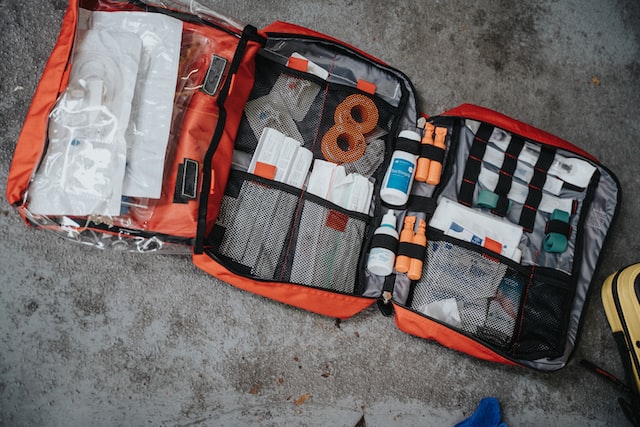
As a responsible pet owner, you should think about having a first aid kit for your pet at home. A first aid kit can go a long way if there is an emergency and your loved paw friend needs help. We will try to help you be more prepared if your dog or cat suffers an injury. As with any other first aid kit, you should try to keep it well-stocked and monitor the expiration dates on the included medicine. Many of the items in a human-grade first aid kit could be used for a pet emergency in a pinch. The American Veterinary Medical Association (AVMA) has an excellent brochure that you can use to familiarize yourself with ways to provide first aid to your dog or cat. Additionally, The People's Dispensary for Sick Animals (PDSA) charity organization has a useful page with advice on handling common injuries in pets.
Always seek veterinary medical care for your pet if he/she is injured. Sometimes you might find yourself in a situation where you have to provide first aid like when you are on a hike in a nature reserve, when you are traveling on a highway, or when you are at home and there is no vet nearby. It is best to have a first aid kit with you in moments like these. We are happy to list what you should include in your kit.
Must-Have Items:
Paperwork
Make sure that your first aid kit includes the vaccination records and any medical records for your dog. In case your dog needs to be treated, the veterinarian has to know if your canine is allergic to anything and if your pet has any chronic illness or genetic conditions. You will want to have a card with the phone number, name, and email address of the vet that you usually use in case they need to be contacted quickly. We encourage you to include the phone numbers and names of at least two more veterinarians in your area in case your preferred vet is not responding to calls and messages. There may be an emergency involving your dog where your phone has no battery or you don’t have phone service. You might be able to use another person’s phone/network to reach out to your preferred veterinarian or any veterinarians in your area. It may be best for the card we mentioned earlier to include the phone numbers of your family members and close friends in case you need to call them and your phone is not charged.
Gauze
We recommend that you put at least 6 rolls of bandage in your first aid kit (preferably a dozen). You should buy a lightweight, latex-free medical gauze that can be used on your pet in case of emergency. You can check this product page to have an idea of what to look for.
Adhesive Tape For Bandages
Do not use human-grade adhesive tapes on pets! There are special adhesive tapes for pets that are meant to secure the gauze. The adhesive tape should be light and breathable. Two rolls should be more than enough as each is about 5 yards (4,5 meters) long. Please, check this product page to have an idea of what to look for.
Non-Stick Bandages
They are usually sold in packs of six and are cheap to buy. Read the label on the product and make sure it is water-repellent. As the name suggests, the non-stick bandages will not stick to the fur of your pet which is very convenient. You can see this product page for reference.
Scissors
Make sure you have a good pair of scissors in your medical aid kit so you can cut to size the gauze, the adhesive tape, and the bandages properly.
Hydrogen Peroxide
This is an excellent solution for cleaning minor wounds to prevent infection. Additionally, it can even be used to induce vomiting in your pet in case he/she has ingested any toxic substances. Acorn squash, butternut squash aloe, avocado, basil, beets, and catnip are toxic to dogs and cats. If you suspect that your dog has eaten something toxic call your veterinarian first before you induce vomiting. PetMD has an excellent guide on how to induce vomiting right here. We can't recommend a particular product, but you will want to look for a bottle that is easy to open like this one here.
Antibiotic Spray/Ointment
Any good first aid kit should include medicine to combat infection. Buy a reliable antibiotic remedy after you consult your veterinarian. If your dog/cat suffers a wound and it gets dirt on it you will need to clean it and disinfect it. Most antibiotic ointments come in the form of a gel and you can find spray bottle variants too. Don’t worry if your pet accidentally ingests some of the medicine, these products are safe for the dog’s digestive system. However, try to prevent your pet from licking the wound where you apply the ointment. A spray may be the preferred option for many since it is easy to use. We recommend buying something like this. The AKC recommends this antibiotic hydrogel.
Cotton Balls
One or two packs of cotton balls should be enough for your kit to be well-stocked. Cotton balls can be very useful when you have to clean a wound of dirt, and then apply an antibacterial ointment or Hydrogen Peroxide. Also, they are also quite affordable.
Eye Dropper (or large syringe without needle)
You will want to include this in your first aid kit as it can be useful for giving oral medicine and flushing wounds.
Muzzle
If your pet is in pain he/she may bite and scratch to defend himself/herself. We recommend you include a muzzle in your first aid kit so you do not suffer an injury when you are trying to help your pet. In an emergency, a necktie, rope, or another soft cloth could be tied around the mouth of your dog.
Extra Leash and Collar
In case you lost the leash or collar of your dog or the gear was damaged in an emergency you should make sure to have spares in your bag.
Flashlight
You may need extra light sometimes and your phone may not do the trick. You need a dedicated flashlight in case you need to pull out a splinter, take a closer look at your dog’s skin, or scare off wild animals that might endanger your pet.
Towels
Grab a few pieces of clean cloth and put them in your first aid kit. These can be used to stop and limit heavy bleeding.
Styptic Powder
This is an invaluable addition to any medical care kit. It can be used to quickly top off bleeding and relieve pain. You may want to see the product here if you are not sure what to buy.
Digital Thermometer
You may be asked to measure your pet’s temperature when you call your vet and ask for help. This model has good reviews and is recommended by many. AVMA suggests that you have to measure the dog's temperature rectally for the best result. Measurements taken orally are not considered reliable. As unpleasant as it may sound, rectal measurements have been tested and recognized by the scientific community as most accurate. Non-contact thermometers have been proven to not work properly, please check this study. The normal body temperature of dogs is 101.5 Fahrenheit (38,36 Celcius). Don’t be surprised if your dog has a temperature that is plus or minus 1 degree. Any greater differences should be considered a reason to call a veterinarian as soon as possible.
Optional Items
Medicine Pillbox
If your dog has any chronic health problems that have to be treated with pills regularly then you need to have a water-resistant pillbox to store the medication. You are welcome to check this product page so you know what to look for.
Blanket
If you are setting up a backpack with first aid supplies we recommend you add a soft blanket that can be used to wrap your pet and make him/her feel safer. The blanket can also help in case your dog has been exposed to extreme cold weather. The blanket can be used as a makeshift stretcher for your pet in case he/she can not walk on their own.
Foldable Stretcher
Alternatively, you can buy a dedicated stretcher for emergencies. A product like this is worth your consideration but it is rather expensive. If you are looking for a more affordable option please check out this product.
Paw Balm
You may also want to add paw balm for your pet’s paws which can help reduce dryness and irritation on the paws of your four-legged companion. A product like this can help a lot for your buddy to feel comfortable. Do not use moisturizer for humans on your pet. This will often make the paws vulnerable to injury.
Saline Eye Solution And Artificial Tear Gel
These remedies can help dogs with eye problems feel more comfortable and stay healthy. The Saline Eye Solution is used to relieve pink eye, allergy symptoms, and infections. It helps prevent abrasions, irritations, and conjunctivitis. Please take a look at this eye wash for dogs and cats which has positive reviews from pet owners. The Artificial Tear Gel can help dogs and cats who are prone to dry eye syndrome stay healthy and avoid abrasions of the eye. Unlike ordinary eye drops tear gel does not evaporate. You can check this product page for more details. Please talk to your veterinarian about the best eye care for your canine and cat.
A QR Code
If your pet has an emergency and you have your phone with you with a good phone service it is possible to access guidance on how to do first aid quickly. You can do that by scanning a QR code and opening the PDSA website we mentioned earlier. The website has guidance on how to move an injured pet and lessons on how to respond to seizures, road accidents, hypothermia, electric shocks, and heatstroke. You can easily make the URL for the online resource into a QR code using a service like this one. You can download the produced image that features the QR code and put that on the card that has your veterinarian's contact information.
Hopefully, now you know what you should include in your Dog First Aid Kit and you are better prepared to handle emergencies involving your pet. If you are not sure which product should be included in your first aid kit, please talk to your veterinarian before you make any purchases. Stay safe and do not forget your first aid kit on your outings.











